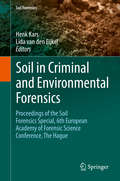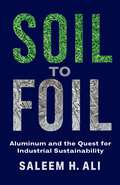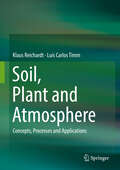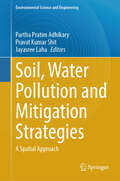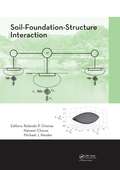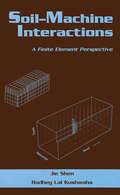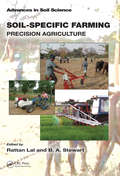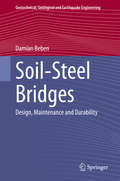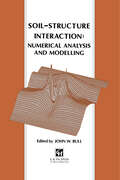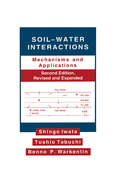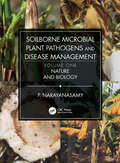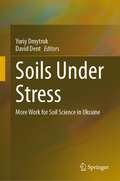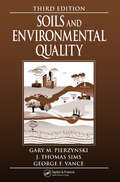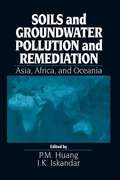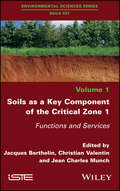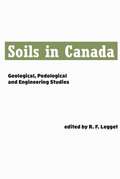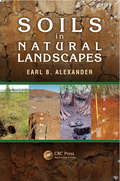- Table View
- List View
Soil behaviour and critical state soil mechanics
by David Muir WoodSoils can rarely be described as ideally elastic or perfectly plastic and yet simple elastic and plastic models form the basis for the most traditional geotechnical engineering calculations. With the advent of cheap powerful computers the possibility of performing analyses based on more realistic models has become widely available. One of the aims of this book is to describe the basic ingredients of a family of simple elastic-plastic models of soil behaviour and to demonstrate how such models can be used in numerical analyses. Such numerical analyses are often regarded as mysterious black boxes but a proper appreciation of their worth requires an understanding of the numerical models on which they are based. Though the models on which this book concentrates are simple, understanding of these will indicate the ways in which more sophisticated models will perform.
Soil in Criminal and Environmental Forensics
by Henk Kars Lida EijkelThis introductory volume to a new series on Soil Forensics gives a kaleidoscopic view of a developing forensic expertise. Forensic practitioners and academic researchers demonstrate, by their joint contributions, the extent and complexity of soil forensics. their reports exemplify the broad range of sciences and techniques applied in all stages of forensic soil examinations, from investigations at crime scenes to providing evidence that can be used in court proceedings. Moreover the necessity is depicted of co-operation as a condition for any work in soil forensics between scientists of different disciplines, but no less between scientists and law enforcers. Soils play a role in environmental crimes and liability, as trace evidence in criminal investigations and, when searching for and evaluating, buried human remains. This book shows soil forensics as practiced in this legal context, emerging and solidifying in many countries all over the world, differing in some respects because of differences in legal systems but ultimately sharing common grounds.
Soil mechanics
by David Muir WoodThis 2009 book teaches the principles of soil mechanics to undergraduates, along with other properties of engineering materials, to which the students are exposed simultaneously. Using the critical state method of soil mechanics to study the mechanical behavior of soils requires the student to consider density alongside effective stresses, permitting the unification of deformation and strength characteristics. This unification aids the understanding of soil mechanics. This book explores a one-dimensional theme for the presentation of many of the key concepts of soil mechanics - density, stress, stiffness, strength, and fluid flow - and includes a chapter on the analysis of one-dimensional consolidation, which fits nicely with the theme of the book. It also presents some theoretical analyses of soil-structure interaction, which can be analyzed using essentially one-dimensional governing equations. Examples are given at the end of most chapters, and suggestions for laboratory exercises or demonstrations are given.
Soil to Foil: Aluminum and the Quest for Industrial Sustainability
by Saleem AliAluminum is the most abundant metal in the earth’s crust. It is also ubiquitous in the modern world, from aircraft to soda cans. A dizzying number of consumer and industrial products employ aluminum, typically alloyed, because of its availability, versatility, and malleability. Today, how efficiently we use—and reuse—aluminum is vital to addressing key environmental challenges and understanding humanity’s fraught relationship with the earth.Soil to Foil tells the extraordinary story of aluminum. Saleem H. Ali reveals its pivotal role in the histories of scientific inquiry and technological innovation as well as its importance to sustainability. He offers compelling portraits of the scientists and innovators who discovered new uses for this remarkable element, ranging from chemistry and geoscience to engineering and industrial design. Ali argues that aluminum exemplifies broader lessons about stewardship of nonrenewable resources: its seeming abundance has given rise to wasteful and destructive practices. Soil to Foil follows aluminum’s path along the supply chain, from extraction to production, consumption to recycling. Ali explores the ecological damage at mine sites and visits affected communities seeking to restore the land. He foregrounds the possibilities for more sustainable industrial practices, emphasizing how product design can incorporate eventual reuse and recycling. Ultimately, Soil to Foil shows that the story of aluminum’s use and misuse helps us rethink how to sustainably manage the resources of our planet.
Soil, Plant and Atmosphere: Concepts, Processes and Applications
by Klaus Reichardt Luís Carlos TimmThis textbook presents the concepts and processes involved in the soil-plant-atmosphere system as well as its applications in the water cycle in agriculture. Although reaching the frontier of our knowledge in several subjects, each chapter starts at the graduation level and proceeds to the post-doctoral level. Its more complicated subjects, as math and physics, are well explained, even to readers not well acquainted with these tools. Therefore, it helps students read, understand, and developing their thoughts on these subjects. Instructors also find it an easy book with the needed depth to be adopted in courses related to Soil Physics, Agricultural Management, Environmental Protection, Irrigation and Agrometeorology. It serves also as “lexicon” to engineers and lawyers involved in agricultural, environmental cases.
Soil, Water Pollution and Mitigation Strategies: A Spatial Approach (Environmental Science and Engineering)
by Pravat Kumar Shit Partha Pratim Adhikary Jayasree LahaDive into the dynamic world of environmental stewardship with "Soil, Water Pollution, and Mitigation Strategies: A Spatial Approach." This meticulously crafted volume offers a comprehensive journey through the measurement, monitoring, mapping, and modelling of soil and water pollution, coupled with innovative mitigation strategies. Discover cutting-edge techniques rooted in modern geospatial methodologies, with a sharp focus on the latest trends in data mining and robust modelling. As our planet grapples with the consequences of anthropogenic activities, such as indiscriminate chemical usage in agriculture, the need for precise quantification and risk assessment has never been more urgent. This book serves as a beacon, illuminating the path toward sustainable management of soil and water resources through the lens of geospatial technology. Explore a myriad of critical topics, including soil microbiology, salinity, pollution from industrial sources, heavy metals, and the pervasive impact of agricultural practices. Delve into environmental risk assessment, sustainable land use, and innovative remediation techniques, such as harnessing the power of Plant Growth-Promoting Rhizobacteria (PGPR) and embracing organic fertilizers. Written for researchers, professionals, and policymakers alike, this book offers invaluable insights into the complex interplay between human activity and environmental health. Organized into two parts (I) Soil Contaminants, Risk Assessment, and Mitigation, and (II) Water Contaminants, Risk Assessment, and Mitigation—it provides a structured approach to understanding and addressing environmental challenges. Each chapter serves as a portal to a deeper understanding of the issues at hand, presenting a synthesis of current research, identifying future directions, and offering pragmatic solutions. This book promises to enrich the understanding of environmental science and empower the reader with the knowledge and skills needed to effect positive change. Designed to cater to a diverse audience—from students and researchers in environmental sciences to policymakers, NGOs, and corporate stakeholders—this book is a testament to the collaborative effort required to safeguard our planet's precious resources. This is a transformative journey toward a more sustainable future—one informed by science, guided by innovation, and driven by a shared commitment to environmental stewardship.
Soil-Foundation-Structure Interaction: A Special Issue Of The International Journal Of Human-computer Interaction
by James R. LewisSoil-Foundation-Structure Interaction contains selected papers presented at the International Workshop on Soil-Foundation-Structure Interaction held in Auckland, New Zealand from 26-27 November 2009. The workshop was the venue for an international exchange of ideas, disseminating information about experiments, numerical models and practical en
Soil-Machine Interactions: A Finite Element Perspective
by ShenAiming to improve work efficiency in such areas as tillage in agriculture, earth-moving in civil engineering, and tunnel-making in sea-bed operations, this work offers an introduction to Finite Element Method (FEM) analysis of soil-machine systems. It explains the advantage of FEM's numerical approach over traditional analytical and empirical methods of dealing with complex factors from nonlinear mechanical behaviour to geometric configurations.
Soil-Specific Farming: Precision Agriculture (Advances in Soil Science)
by Rattan Lal B. A. StewartFaced with challenges of resource scarcity and environmental degradation, it is important to adopt innovative farming systems that maximize resource efficiency while protecting the environment. Soil-Specific Farming: Precision Agriculture focuses on principles and applications of soil-specific farming, providing information on rapidly evolving agri
Soil-Steel Bridges: Design, Maintenance and Durability (Geotechnical, Geological and Earthquake Engineering #49)
by Damian BebenThe primary objective of this book is to provide designers with a set of analysis and design specifications for soil-steel bridges and culverts, also called flexible structures. Brief but informative, this guide is based on a quick look up approach to code applications, design and analysis methods/calculations as well as applications and solved examples. The book addresses the unique aspects of soil-steel bridges: design and analysis as well as examples of applications, numerical analysis and modeling techniques, corrosion and durability problems, service life and maintenance, and impact of moving loads.
Soil-Structure Interaction: Numerical Analysis and Modelling
by John W. BullThis book describes how a number of different methods of analysis and modelling, including the boundary element method, the finite element method, and a range of classical methods, are used to answer some of the questions associated with soil-structure interaction.
Soil-Water Interactions: Mechanisms Applications, Second Edition, Revised Expanded (Books In Soils, Plants And The Environment #Vol. 14)
by Shingo IwataEmphasizing pioneering achievements, this work offers a clear and systematic description of various soil-water phenomena and their applications to soil problems such as water retention and the flux of water in soils and clays. This second edition contains material on the physical properties of adsorbed water, the application of fractal theory to solute and water flows in field soils, fingering research, and more.
Soil-Water, Agriculture, and Climate Change: Exploring Linkages (Water Science and Technology Library #113)
by Pankaj Kumar Gupta Swatantra Kumar Dubey Prakash Kumar Jha Aliva Nanda Vivek GuptaThis book presents an exploration of linkages among soil-water, agriculture, and climate change with a special focus on thematic areas for assessment, mitigation, and management of natural resources under climate change conditions. This book covers advances in modelling approaches, including machine learning (ML)/ artificial intelligence (AI) applications; GIS and remote sensing; sensors; impacts of climate change on agriculture; subsurface water; contaminants; and socio-economic impacts, which are lacking in a more comprehensive manner in the previous titles. This book encompasses updated information as well as future directions for researchers working in the field of management of natural resources. The goal of this book is to provide scientific evidence to researchers and policymakers and end-to-end value chain practitioners which may help in reducing the overall adverse impacts of climate change on water resources and the related mitigation strategies. This book focuses on the knowledge, modern tools, and techniques, i.e., machine learning, artificial intelligence, etc. for soil-water, agriculture, and climate change. Further, nature-based solutions for management of natural resources with special targets on contaminants, extreme events, disturbances, etc. will be targeted. The book provides readers with the enhanced knowledge for application of engineering principles and economic and regulatory constraints to determine a soil-water, agriculture production action strategy, and select appropriate technologies to implement the strategy for a given data set at a site. It would also cover the application of laboratory, modeling, numerical methods for determination and forecasting of climate change impacts, agriculture production, pollution, soil health, etc. Overall, it provides hydrologists, environmental engineers, administrators, policy makers, consultants, and industrial experts with essential support in effective management of soils health, agricultural productions, and mitigation of extreme climatic events.
Soil-Water-Solute Process Characterization: An Integrated Approach
by Javier Álvarez-Benedí Rafael Muñoz-CarpenaThe practitioner or researcher often faces complex alternatives when selecting a method to characterize properties governing a soil process. After years of research and development, environmental and agricultural professionals now have an array of methods for characterizing soil processes. Well-established methods, however, may not be suitable for
Soilborne Microbial Plant Pathogens and Disease Management, Volume One: Nature and Biology
by P. NarayanasamySoilborne microbial plant pathogens including oomycetes, fungi, bacteria and viruses cause several economically important destructive diseases and the symptoms of infection can be recognized only after the pathogen has invaded many tissues primarily vascular tissues of susceptible plants. This condition places formidable challenges in investigating different aspects of host-microbial pathogen interactions. Early detection of infection and precise identification, differentiation, and quantification of the microbial plant pathogens in plants, soil and water sources are essential requirements for development of effective tactics to reduce the incidence and spread of the diseases caused by them. As the microbial plant pathogens differ in their virulence and sensitivity to the environment and chemicals applied, it is imperative to assess the extent of variability in the concerned pathogens. This first volume of a two-volume set introduces disease-causing microorganisms including oomycetes, fungi, bacteria, and viruses found in soils. It focuses on the biology, detection, and identification of soilborne bacterial, fungal, and viral plant pathogens. This volume discusses various techniques based on biological, immunological and genetic properties of the pathogens indicating their advantages and limitations for selecting the appropriate technique to fulfill the requirements. Features: Presents techniques useful for detection, identification, quantification of microbial plant pathogens in plants, soil, and irrigation water from waterbodies. Highlights subversive activities of viruses, resulting in the breakdown of host defense systems. Discusses RNA silencing in infected plants by viruses and posttranscriptional gene silencing (PTGS) functioning as an endogenous mechanism in plants against virus infection. Presents information on methods of assessment of genetic variability and sensitivity of microbial plant pathogens to chemicals and adverse environmental conditions.
Soilborne Microbial Plant Pathogens and Disease Management, Volume Two: Management of Crop Diseases
by P. NarayanasamyCrop disease management strategies revolve around the principles of exclusion, eradication and immunization. Cultural practices are aimed at preventing or reducing the accumulation of pathogen population (inoculum). Development of cultivars with genetic resistance by transgressing resistance gene(s) through traditional breeding procedures or biotechnological techniques is the most effective and acceptable strategy, as it is environment-friendly and does not need any additional cost to the grower. Assessment of different grades of resistance of cultivars or genotypes to soilborne microbial pathogens has been possible by quantifying pathogen populations or their DNA contents in the test plants by applying biological and molecular methods. This second volume of a two-volume set focuses on the soilborne microbial plant pathogens and the diseases caused by them. The book provides information on ecology and epidemiology of soilborne microbial plant pathogens and various strategies applicable for effective management of diseases. Chapters cover exclusion and prevention strategies; improvement of host plant resistance; biological management; application of chemicals; and integration of these disease management strategies. Features Discusses various aspects of soilborne microbial plant pathogens to develop effective methods of managing diseases. Presents information on epidemiology and ecology of soilborne microbial plant pathogens. Facilitates the application of management strategies alone or in combination with others for effective suppression of disease development. Features information on application of biotic and abiotic biological control agents (BCAs) to suppress pathogen development either by directly acting on the pathogen(s) or indirectly by enhancing host resistance to the pathogens. Employs biotic and abiotic biocontrol agents either to replace or reduce the use of chemicals is an achievable approach for managing the soilborne microbial pathogens.
Soils
by Randall J. Schaetzl Michael L. ThompsonSoils: Genesis and Geomorphology is a comprehensive and accessible textbook on all aspects of soils. The book's introductory chapters on soil morphology, physics, mineralogy and organisms prepare the reader for the more advanced and thorough treatment that follows. Theory and processes of soil genesis and geomorphology form the backbone of the book, rather than the emphasis on soil classification that permeates other less imaginative soils textbooks. This refreshingly readable text takes a truly global perspective, with many examples from around the world sprinkled throughout. Replete with hundreds of high quality figures and a large glossary, this book will be invaluable for anyone studying soils, landforms and landscape change. Soils: Genesis and Geomorphology is an ideal textbook for mid- to upper-level undergraduate and graduate level courses in soils, pedology and geomorphology. It will also be an invaluable reference text for researchers.
Soils Under Stress: More Work for Soil Science in Ukraine
by David Dent Yuriy DmytrukDokuchaev carried out most of his research in Ukraine. His student and friend, Volodymyr Vernadsky, went on to create trans-disciplinary environmental sciences and the concept of Earth as a living organism, famously taken up by James Lovelock. That spring of ideas still flows and the researches captured in this volume are relevant to present-day problems, and not only in Ukraine.Soils have always been under stress but, in the Anthropocene, mankind is in the driving seat. As a sequel to Soil Science Working for a Living: Applications of soil science to present-day problems, we consider issues of policy as well as soil genesis, attributes and functions in various environments, natural and man-made. We consider human impacts on the soil cover through its use and misuse, highlight methods of research and assessment of soil quality, and the threats of soil degradation. The distinguished contributors also describe and propose various options for evaluation and remediation of degraded soils, drawing on the latest methods of modelling and cartography as well as long-term field experiments and long experience.The book will be invaluable to researchers and practitioners in soil science including graduate and post-graduate education, academics and professionals.
Soils and Environmental Quality
by Gary M. Pierzynski George F. Vance J. Thomas SimsA perpetual bestseller, this third edition explores environmental quality from the perspective of soil science. The coverage ranges from the theoretical to the practical with an abundance of examples such as an exploration of allowable pesticide concentrations in drinking water and an inquiry into soil contamination from the trace elements in organic by-products. It also explores the use of soil carbon sequestration as a remedy for global climate change and the effects of acid precipitation on forestation. Case studies with political, economic, and legal implications illustrate the human side of environmental problems. Also covered is the use or misuse of the Scientific Method and the potential for factual bias.The three authors, all teaching professors distinguished in soil science, have updated this student favorite to include a greater number of even more relevant topics. Responding to reques
Soils and Geotechnology in Construction
by Alan J. LuteneggerThis book covers the field of applied geotechnology related to all aspects of construction in ground, including compacted fill, excavations, ground improvement, foundations, earth retaining systems and geotechnical site characterization. It suits the first year of a graduate course on ground improvement and geoconstruction and will suit practicing engineers, both consultants and contractors. Distinctively it covers the identification of problematic soils and appropriate mitigation measures, and the inspection of ground construction work. It combines the technical and the practical in applied geotechnology.
Soils and Groundwater Pollution and Remediation: Asia, Africa, and Oceania
by P. M. Huang I.K. IskandarThe increasing population densities of Asia, Africa and Oceania are in conflict with the ecosystem. A growing demand for food and fiber causes agriculture to rely heavily upon chemical fertilization, herbicides and pesticides. Rising industrial output creates higher contamination from cadmium, lead, selenium, and other metals. Soils and Groundwater Remediation explores the toxic levels of metals, radionuclides, inorganics, and anthropogenic organic compounds found in the soils and groundwater of Asia, Africa and Oceania. This 14 chapter book reviews the distribution, transformation, and dynamics of the pollutants. The authors also reflect on the impact of Acid-rain. The contributors to this book are well-known scientists from Japan, China, Korea, Malaysia, New Zealand, Australia, and Kenya. The authors address their findings to researchers, educators, government regulators, and students. As the title suggests, the book is ultimately concerned with remediation. Huang and Iskandar feel "the potential for restoring ecosystem health ... in these areas is enormous." The contributions of Soils and Groundwater Remediation will bring science closer to achieving that possibility.
Soils and Human Health
by Eric C. Brevik Lynn C. BurgessDespite the connections between soils and human health, there has not been a great amount of attention focused on this area when compared to many other fields of scientific and medical study. Soils and Human Health brings together authors from diverse fields with an interest in soils and human health, including soil science, geology, geography, bio
Soils as a Key Component of the Critical Zone 1: Functions and Services
by Jean Charles Munch Jacques Berthelin Christian ValentinThis introductory book to the six volume series includes an introduction defining the critical zone for mankind that extends from tree canopy and the lower atmosphere to water table and unweathered rock. Soils play a crucial role through the functions and the services that they provide to mankind. The spatial and temporal variability of soils is represented by information systems whose importance, recent evolutions and increasingly performing applications in France and in the world must be underlined. The soil functions, discussed in this book, focus on the regulation of the water cycle, biophysicochemical cycles and the habitat role of biodiversity. The main services presented are those related to the provision of agricultural, fodder and forest products, energy, as well as materials and the role of soil as infrastructure support. They also include the different cultural dimensions of soils, their representations being often linked to myths and rites, as well as their values of environmental and archaeological records. Finally, the issue is raised of an off-ground world.
Soils in Canada: Geological, Pedological and Engineering Studies (The Royal Society of Canada Special Publications #3)
by Robert LeggetThis work originated in a Symposium forming part of the programme for Section IV (Geological Sciences including Mineralogy) of the Royal Society of Canada, which met at Queen's University, Kingston, in 1960. Of wide scope, it demonstrates the progress now being made in Canada in the study of its vast area of soils. The papers of this Symposium are unique in that they present for the first time a combined picture of three aspects of soil science–the geological, the pedological (or agricultural), and the engineering (known as Soil Mechanics). The book serves, of course, mainly as an introduction to a large subject, but some more detailed papers give an idea of the depth as well as the wide range of soil studies in Canada today. The contents can be summarized as follows. First come seven papers on Pleistocene geology in Canada, followed by a study of muskeg (which forms half a million square miles of Canada's surface) and one of soil mineralogy. Four papers–one general and three regional–of pedological interest follow. Finally come four papers on soil mechanics: one relating agricultural and engineering soil studies; one discussing geology's influence on the siting and building of airports; a detailed account of the properties of Leda clay; and a general review of the soil problems facing the Canadian civil engineer.
Soils in Natural Landscapes
by Earl B. AlexanderIn any complete investigation of terrestrial ecosystems, rocks and soils must be considered. Soils are essential resources, providing water and nutrients for vascular plants, and mitigating the flow of water from the land. In addition, soil diversity is critical for biotic diversity. While there are many references on the agricultural perspective o

